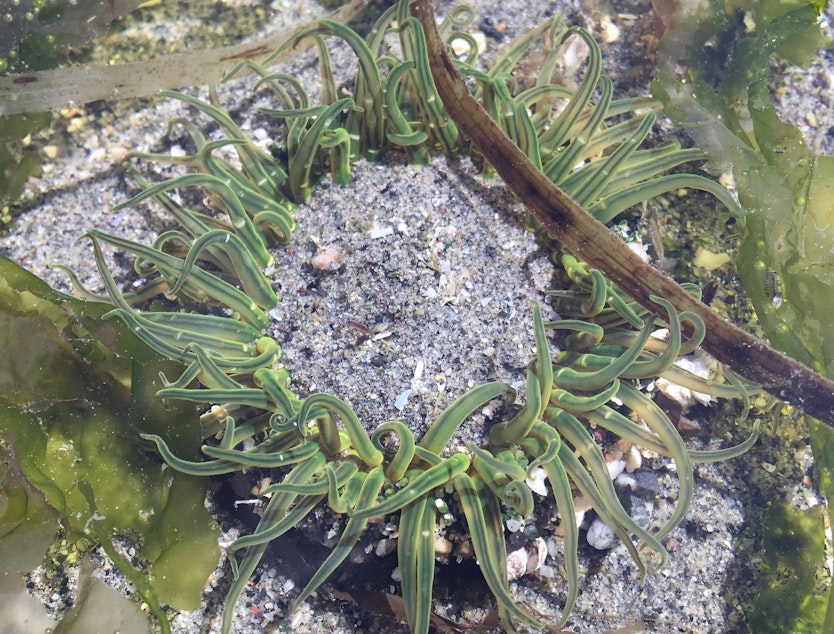Lowest tides in 13 years coming to Puget Sound
Puget Sound should see its lowest tides in more than a decade on Wednesday and Thursday.
Very low tides come every summer, driven by the relative positions of the earth, moon, and sun.
But thanks to an 18.6-year wobble in the moon’s orbit, the lows are extra low this summer.
That wobble, known as the lunar nodal cycle, is nearing its 2025 peak, and it is helping the tide slosh in and out of Puget Sound a little more powerfully than usual.
“We are approaching a peak of the lunar nodal cycle, in which the difference between the high and low tides will be larger than it is at other times,” said Port Angeles-based oceanographer Ian Miller with Washington Sea Grant.
Miller says the cycle can push a low tide down an extra six inches.
Sponsored
Puget Sound tides are expected to retreat to an unusual degree the week of June 12, exposing areas that are seldom left high and dry.
The rare and fleeting retreat of the sea presents a great opportunity for people who like to explore tidepools, but it can be a dangerous time for creatures that are almost always underwater.
“In the lower part of the intertidal, you get into a lot more soft-body creatures, things that are not able to withstand desiccation very well,” Miller said.
Many coastal parks will have beach naturalists on hand this week to help people learn about the squishy, salty wildlife they can encounter in these rarely exposed areas.
Find times and locations to catch up with a beach naturalist this week here: King County, Snohomish County, and Thurston County.
Near the water’s edge, some sea creatures could be exposed to air for the first time in their lives, putting them under unprecedented stress.
“Just step carefully,” Miller said. “A lot of these organisms are soft-bodied, and, aside from the exposure they're experiencing to the air, which is atypical for them, they can also be damaged by footfalls and certainly being picked up.”
The lowest of the low is forecast for midday Wednesday, when tides in central Puget Sound are predicted to drop 4 feet or more below the average daily low tide (known as mean lower low water).
The last time the Seattle area had a tide that low was 2009.
On a beach with a typical 2% slope, about 200 extra feet of land will appear when the tide drops 4 feet below average.
Sponsored
Fortunately, there’s no heat wave in the forecast, unlike June 2021, when record-shattering heat coincided with some of the year’s lowest tides to kill hundreds of millions of shellfish and other tideland animals in Washington and British Columbia.
In the early 20th century, tides this low occurred fairly regularly—a few times a year most years, according to NOAA tidal-gauge data for Seattle compiled by Miller—but rising sea levels have made them rare.
Over the past century, the average sea level has risen about 8 inches in Seattle, as it has globally. A warming climate, fueled by fossil-fuel combustion and other pollution, has caused the world’s oceans to swell.
High tides are also expected to reach unusual heights the week of June 12, but they probably won’t approach the record high tides that flooded parts of the region in January. Those “king tides” got a boost from a low-pressure weather system that lessened the weight of air pushing the sea down, letting the tide in Port Townsend, Seattle, and Tacoma bulge nearly two feet higher than tide tables predicted.
Sponsored
In a bulletin issued in May for the West Coast, the National Oceanographic and Atmospheric Administration said that the Seattle area and parts of Southern California should expect unusually high tides and minor coastal flooding as well as unusually low tides June 12-16, July 11-16, and Aug. 9-12.
If a storm coincides with those high tides, more serious flooding could occur.
The unusually wide swings between extreme tides are likely to bring powerful currents, a potential hazard to boaters, in places like Deception Pass, Tacoma Narrows, and the San Juan Islands.





